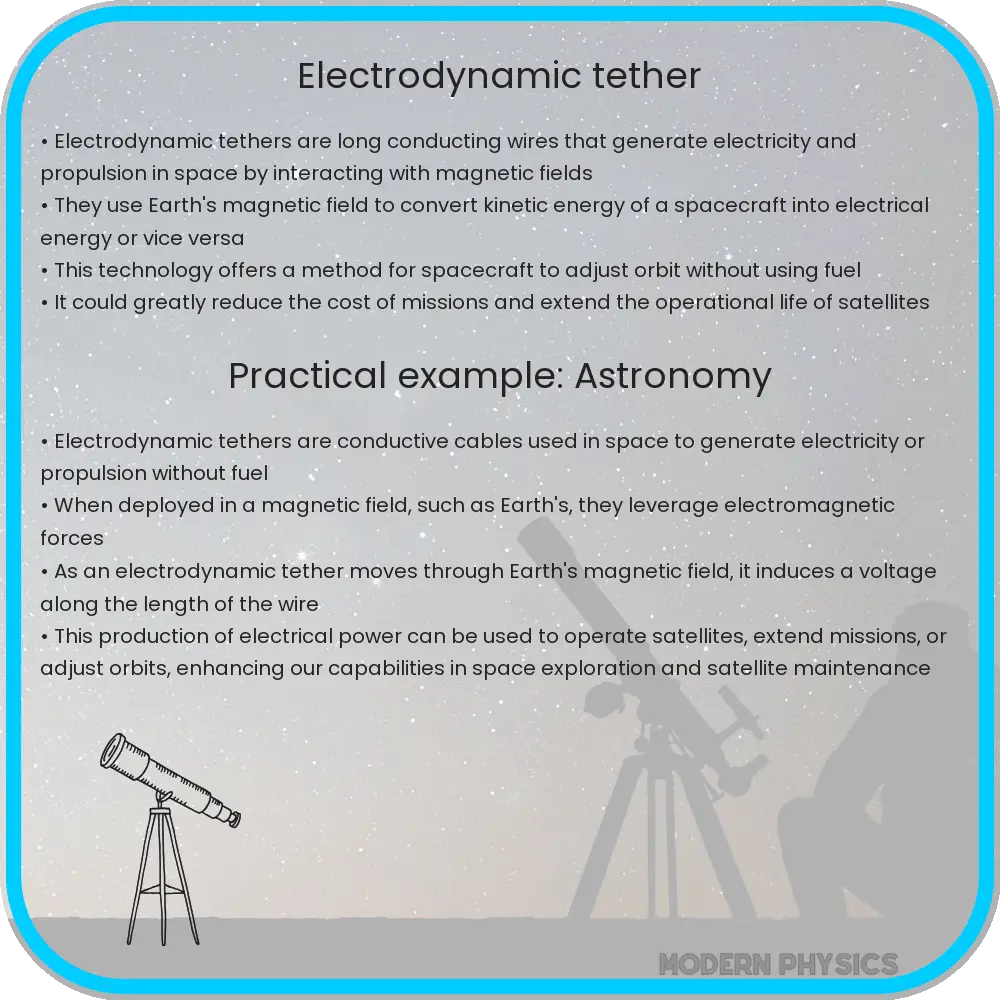Explore how Electrodynamic Tethers revolutionize space technology, offering sustainable propulsion and effective space debris mitigation.

Understanding Electrodynamic Tethers in Space Applications
Electrodynamic tethers (EDTs) present a revolutionary approach in the field of space technology, offering dual benefits for space propulsion and mitigating space debris. These long conductive cables, when deployed in space, interact with the Earth’s magnetic field to produce a Lorentz force, which can be harnessed for various applications.
Principles of Electrodynamic Tethers
The underlying principle of an EDT is based on the fundamental laws of electromagnetism. When a conductive tether moves through a magnetic field – such as the Earth’s geomagnetic field – an electric current is induced along the length of the tether. This current, in turn, generates a magnetic field that interacts with the Earth’s magnetic field, resulting in the Lorentz force. The direction and magnitude of this force can be altered by changing the current’s direction or strength, allowing precise control of the tether’s motion.
Space Debris Mitigation
One of the critical applications of EDTs is in the realm of space debris mitigation. Space debris, consisting of defunct satellites, spent rocket stages, and fragments from collisions, poses a significant risk to operational spacecraft and satellites. EDTs can be used to safely deorbit this debris. By attaching an EDT to debris and extending it, the Lorentz force can gradually lower the debris’s orbit, eventually leading it to re-enter the Earth’s atmosphere where it harmlessly burns up.
Propulsion and Power Generation
Besides debris mitigation, EDTs offer an innovative propulsion method for spacecraft. Unlike conventional rocket engines that rely on chemical reactions, EDTs provide propulsion without expending fuel. This method is particularly advantageous for long-duration missions where carrying large amounts of fuel is impractical. Additionally, EDTs can generate electrical power by harnessing the difference in potential between the ends of the tether, a process known as electrodynamic braking. This feature adds a self-sustaining element to spacecraft, reducing the need for external power sources.
Challenges and Future Prospects
Despite their potential, EDTs face technical challenges, such as durability in the harsh space environment and the need for precise control mechanisms. However, ongoing research and advancements in materials science are addressing these issues, paving the way for their wider adoption in future space missions.
Advanced Applications and Experimental Missions
Advanced applications of electrodynamic tethers include altering a spacecraft’s orbit without using propellant and stabilizing satellites’ attitudes. This technology is being tested in several experimental missions. For instance, missions like the Tether Electrodynamic Propulsion CubeSat Experiment (TEPCE) aim to demonstrate the feasibility of using EDTs for spacecraft propulsion and orbit maneuvering. Such missions provide valuable insights into the practical challenges and operational capabilities of EDTs in space.
Integration with Other Space Technologies
The integration of EDTs with other space technologies opens up new possibilities. For example, combining EDTs with solar sails or ion drives could lead to more efficient and versatile spacecraft propulsion systems. These hybrid systems could leverage the strengths of each technology, offering more control over spacecraft trajectories and enabling more complex space missions.
Environmental and Economic Implications
From an environmental perspective, the use of EDTs in mitigating space debris is particularly significant. By efficiently removing debris, EDTs can help preserve the space environment, ensuring the safety and sustainability of future space operations. Economically, the reduced reliance on chemical propellants and the potential for longer mission lifespans make EDTs an attractive option for space agencies and private space companies alike.
Conclusion
In conclusion, electrodynamic tethers represent a transformative technology in space exploration and debris management. By harnessing the principles of electromagnetism, they offer a sustainable and efficient solution for propulsion and power generation in space. The ongoing research and experimental missions are addressing the current challenges and unlocking the full potential of this technology. As we continue to explore and utilize space, EDTs stand as a promising tool in our endeavor to make space operations more sustainable, safe, and cost-effective.
